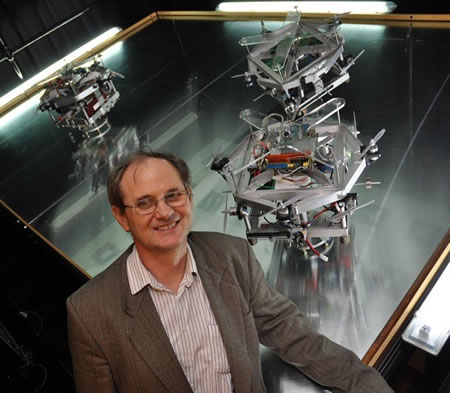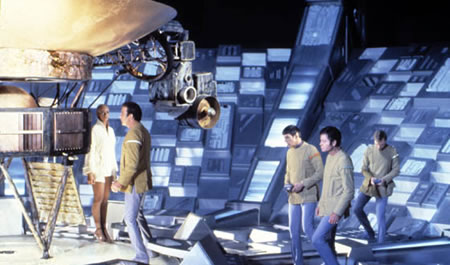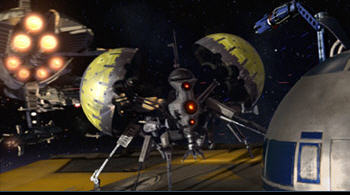Science Fiction
Dictionary
A B C D E F G H I J K L M N O P Q R S T U V W X Y Z
Sysbrain Lets Satellites Think For Themselves

Sysbrain is a cognitive software agent written especially for satellites, to help them act autonomously while in orbit. Sysbrain even allows satellites to go out on the human Internet and read English-language technical documents and receive instruction on subjects like identifying and avoiding obstacles.
Sysbrain is being developed at the University of Southampton by Professor Sandor Veres; he states that
“We have invented sysbrain to control intelligent machines. Sysbrain is a special breed of software agents with unique features such as natural language programming to create them, human-like reasoning, and most importantly they can read special English language documents in ‘system English’ or ‘sEnglish’. Human authors of sEnglish documents can put them on the web as publications and sysbrain can read them to enhance their physical and problem solving skills. This allows engineers to write technical papers directly for sysbrain that control the machines.”

(From Prof. Sandor Veres with sysbrain test satellites)
To test the control systems that could be applied in a space environment, Professor Veres and his team constructed a unique test facility and a fleet of satellite models, which are controlled by the sysbrain cognitive agent control system.The ‘Autonomous Systems Testbed’ consists of a glass covered precision level table, surrounded by a metal framework, which is used to mount overhead visual markers, observation cameras and isolation curtains to prevent any external light sources interfering with experimentation. Visual navigation is performed using onboard cameras to observe the overhead marker system located above the test area. This replicates how spacecraft would use points in the solar system to determine their orientation.
The perfectly-balanced model satellites, which rotate around a pivot point with mechanical properties similar to real satellites, are placed on the table and glide across it on roller bearings almost without friction to mimic the zero-gravity properties of space. Each model has eight propellers to control movement, a set of inertia sensors and additional cameras to be ‘spatially aware’ and to ‘see’ each other. The model’s skeletal robot frame also allows various forms of hardware to be fitted and experimented with.
I was trying to think of examples of satellites thinking for themselves, which should strike you as a fair topic for science fictional treatment. For example, the first Star Trek movie contained Vger, which had been reprogrammed and enhanced in an alien encounter (if I remember correctly). V;ger was not strictly speaking a satellite, but rather an explorational vehicle, but it's close.

(V'ger from Star Trek: The Motion Picture)
More recently, Lucasfilms has done its best to create autonomous weaponized nanosatellites. The buzz droid from Revenge of the Sith has the following characteristics:
An insidious weapon unveiled by the Confederacy of Independent Systems during the later stages of the Clone Wars, buzz droids are tenacious saboteurs launched onto enemy starfighters via specialized missiles. When the missile achieves an optimum proximity to its target, it fragments to unleash a cloud of melon-sized metal spheres into the target's flight path. The spheres attach themselves to a target vessel, popping open to reveal an insect-like droid equipped with cutters and other tools of vandalism...

(From Star Wars Buzz Droid)
Perhaps readers can think of other examples.
From University of Southampton press releasevia our friends at Frolix_8.
Scroll down for more stories in the same category. (Story submitted 2/18/2011)
Follow this kind of news @Technovelgy.| Email | RSS | Blog It | Stumble | del.icio.us | Digg | Reddit |
Would
you like to contribute a story tip?
It's easy:
Get the URL of the story, and the related sf author, and add
it here.
Comment/Join discussion ( 7 )
Related News Stories - (" Space Tech ")
Will Space Stations Have Large Interior Spaces Again?
'They filed clumsily into the battleroom, like children in a swimming pool for the first time, clinging to the handholds along the side.' - Orson Scott Card, 1985.
Reflect Orbital Offers 'Sunlight on Demand' And Light Pollution
'I don't have to tell you about the seven two-mile-diameter orbital mirrors...'
Chrysalis Generation Ship to Alpha Centauri
'This was their world, their planet —
this swift-traveling, yet seemingly moveless vessel.' - Nat Schachner, 1934
The First Space Warship For Space Force
'Each of the electrical ships carried about twenty men...' - Garrett P. Serviss, 1898.
Technovelgy (that's tech-novel-gee!) is devoted to the creative science inventions and ideas of sf authors. Look for the Invention Category that interests you, the Glossary, the Invention Timeline, or see what's New.
Science Fiction
Timeline
1600-1899
1900-1939
1940's 1950's
1960's 1970's
1980's 1990's
2000's 2010's
Current News
Natural Gait With Prosthetic Connected To Nervous System
'The leg was to function, in a way, as a servo-mechanism operated by Larry’s brain...'
Woman Marries Computer, Vonnegut's Dream Comes True
'Men are made of protoplasm... Lasts forever.'
Spidery 'Walk Me' Toyota Autonomous Wheel Chair Like Star Wars
Walk along with the emperor.
Dancing Robots Taught Dance Moves
'A clockwork figure would be the thing for you...'
Proof Of Robothood - Not A Person
'Who are you people? - Show 'em.'
Indonesian Clans Battle
'The observation vehicle was of that peculiar variety used in conveying a large number of people across rough terrain.'
The 'Last Mile' In China Crowded With Delivery Robots
Yes, it's a delivery robot. On wheels.
Tornyol Microdrone Kills Mosquitoes
'The real border was defended by... a swarm of quasi-independent aerostats.'
PLATO Spacecraft, Hunter Of Habitable Planets, Now Ready
'I ... set my automatic astronomical instruments to searching for a habitable planet.'
Factory Humanoid Robots Built By Humanoid Robots
'...haven't you a section of the factory where only robot labor is employed?'
iPhone Air Fulfils Jobs' Promise From 2007 - A Giant Screen!
'... oblongs were all over the floor and surfaces.'
ChatGPT Now Participates in Group Chats
'...the city was their laboratory in human psychology.'
iPhone Pocket All Sold Out!
'A long, strong, slender net...'
Did The Yautja Have These First?
What a marvel of ingenuity the little device was!
Jetson ONE Air Races Begin, Can Air Polo Be Far Behind?
'If you're one of those rarities who haven't attended a rocket-polo "carnage", let me tell you it's a colorful affair.'
Will Space Stations Have Large Interior Spaces Again?
'They filed clumsily into the battleroom, like children in a swimming pool for the first time, clinging to the handholds along the side.'
